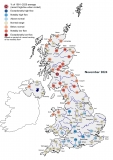Submitted by Michael Eastman on
Changeable conditions with heavy rain and showers bookended a settled and warm period in July. It was the fifth warmest July for the UK (in a series from 1884) and a record maximum temperature for Northern Ireland of 31.3°C was recorded on the 21st at Castlederg (County Tyrone). During the settled period, temperatures regularly exceeded 30°C and the Met Office issued the first amber heat warning (the system began operation in June 2021) for unusually high temperatures in western areas. Although July rainfall totals were near average for the UK, there was a stark contrast between drier conditions in most northern and western areas and wet weather elsewhere. This distribution was reflected in river flows with above normal flows in southern and central England and below normal flows in Wales, northern England and Northern Ireland. Soils were drier than average across the UK, except in the Southern and North-East regions in England. The seasonal groundwater recession continued at the vast majority of sites, and levels in the Chalk and Carboniferous Limestone aquifers were in the normal range. Above normal levels were observed in northern England, with record high July levels in two boreholes. Reservoir stocks at the national scale fell to below average for July, with some impoundments in Scotland (Daer and Lochs Katrine and Thom) ending the month at just over half of capacity. A continued period of rainfall is required to ameliorate soil moisture deficits in parts of north-east Scotland and campaigns persist to encourage reduced water usage. Continued caution is also required in areas dependent on surface water supplies in Wales, Northern Ireland and north-west England.



